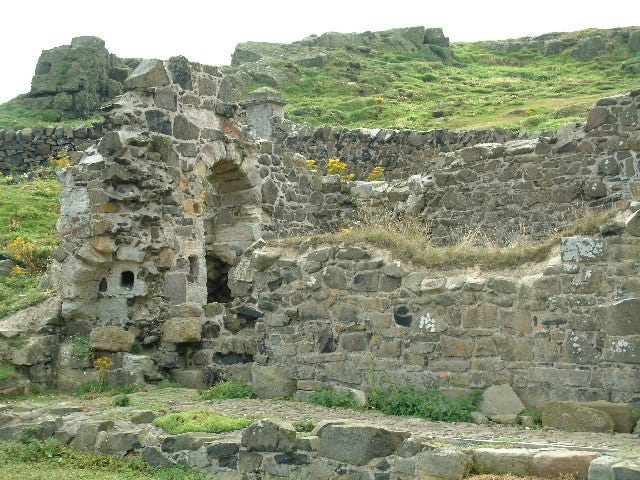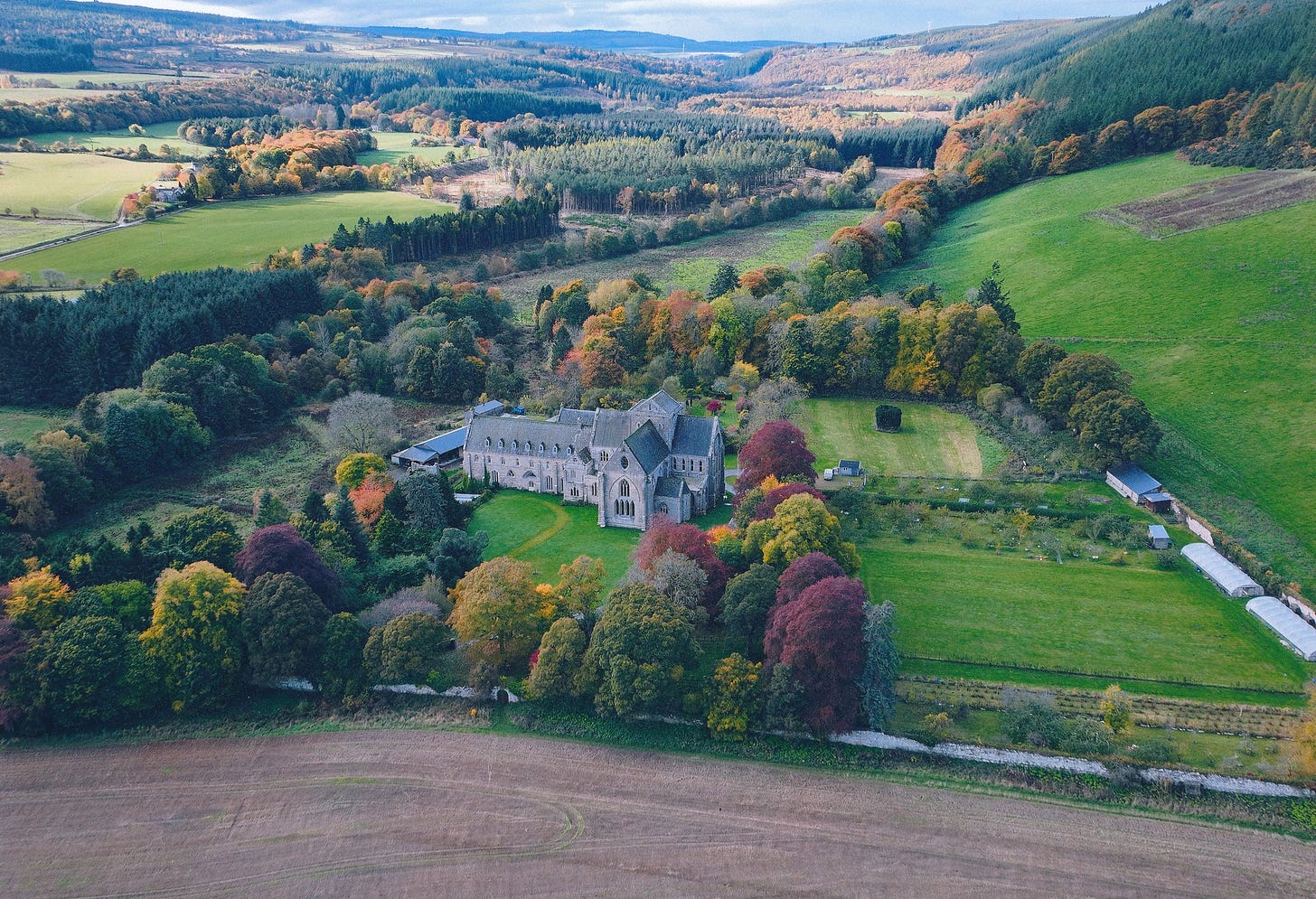Hidden Scottish Catholicism
Finding those Following the Rule of St Benedict.
“It is time now for us to rise from sleep!” St Benedict (c480-547)
For this instalment of the Hidden Scottish Catholicism series, I reveal some of Scotland’s historical religious houses that followed the 6th-century rule of St Benedict. The arrival of such houses in Scotland was a relatively late development. Likely, the life and death of St Margeret (1045-1093) is responsible for the initial settling of the order in Scotland. Much information on these houses has disappeared since the Scottish Reformation.
If we consider the purpose of these abbeys, priories and cells it feels that many were almost meant to be hidden. After all, as opposed to mendicant orders’ public ministry, the Benedictine mission revolves around living a monastic life dedicated to God. Emphasizing community, prayer, work, and hospitality. How wonderful then to find these communities in remote areas where pilgrims and other travellers were able to find shelter when needed. So, let’s rediscover some of these places that, unless you go look for them, are hidden from plain sight.
Isle of May Priory
Located on the Isle of May in the Firth of Forth, the Isle of May Priory was founded in 1145. Inhabited by 9 English Benedictines that originated from Reading Abbey in Berkshire, this religious house was built at the request of King David I (c1084-1153) of Scotland. He gave the island to the monks with the understanding that they were to pray for the souls of the Kings of Scots. The island has a strong connection with St Adrian and the monastery was dedicated to St Mary the Virgin. It included a shrine to 7th-century Scottish martyr and saint, St. Ethernan.
Its exposed position, and the difficulty of access to it in stormy weather, made it anything but a desirable location for a religious house. Although, for tough Scandinavian raiders this didn’t seem much of a problem. As a result, after only 243 years its people were moved and its original owners sold the site to the Bishop of St Andrews.
These days we find some oblong shaped ruins of what once were the priory buildings. The only characteristics that point to the original Benedictine priory are two lancet windows towards the west and the remains of a third in the north gable. Further windows may have been part of the Priory church or chapel. There are also clues of structures south of the main ruins as well as a large burial ground.
I you want to get an impression of the brutal conditions these religious men lived in you can take a boat from Anstruther. But be mindful, we are in Scotland, so this is weather permitting.
Fyvie Priory
Above: Pictish and early-Christian stones at Fyvie
© Historic Environment Scotland
Located in gentler pastures, Fyvie Priory in Aberdeenshire is not often mentioned. This small cell belonged to the Tironensian Order, a strict Benedictine order that was influential in Scotland, particularly during the 12th century. Founded in France, they established several abbeys in Scotland, amongst which were the abbeys of Kelso, Kilwinning, Lindores, and Arbroath. The latter is where Fyvie belonged to. It was founded in 1179 by Earl Fergus of Buchan and received additional endowments from Reginald le Cheyne in 1285.
Not much is known or written of its history. Interestingly whenever Fyvie priory is mentioned in protestant writings, the unhappy state of the brethren is mentioned. Often this is related to the misunderstanding of the "Chapter of Faults ". It is here that the monks, several times a week, voluntarily confessed sins or any breaches of external observance. However, rather than this pointing to the unhappy place the brethren found themselves, these proceedings indicative of the high state of discipline in the mother abbey.
In 1470 Prior Alexander Mason built the church of which a few remains are still to be seen near the banks of the river Ythan. However, these are becoming less and less obvious. Sometimes it is nice to quietly stand in a place and consider how things may have looked to the brethren in medieval times. While the countryside here is still very quiet, I think they themselves will have found it bustling these days. A cairn and cross were erected in 1868 to mark the site of the buildings. Monkshill, now to be found on the edge of the small village, is also a reference to the memory of this small cell in the valley of the Ythan.
Saddell Abbey
Ruins of choir and north transept from Undiscovered Scotland
Hidden due to its remoteness Saddell Abbey, sometimes also referred to as Sagadull, Saundle and Sandale, is located off a small winding road on the east coast of the Kintyre peninsula. This religious house of the Cistercian Order was started in the 1140s. The '' White Monks," often called so to distinguish them from the Benedictines proper, or ''Black Monks"; are sometimes also called " Bernardines," in memory of their most famous abbot, the great St Bernard of Clairvaux (1090-1153).
Bishop Malachy of Armagh felt that the remote area was the perfect location for an order that strictly interprets the Rule of Saint Benedict. Somerled, also known as ''King of the Isles" and a powerful noble in Kintyre, granted the land and the building of the abbey began in 1148. The monks that inhabited this religious house came from Mellifont in County Armagh, Ireland.
Taking the time to visit the ruins in this peaceful, beautiful location, it is not difficult to imagine this house of God was thriving in its time. Walking around the side it isn’t necessarily the cluster of stone walls, the remains of the north transept or choir of the abbey church that transforms us to a time long gone. Nor is the low oblong stone walls almost lost in the infringing woodland, once part of the refectory and undercroft. No, it is instead the noteworthy medieval grave slabs and effigies, a worthy reminder of the active life in this remote abbey. These are now located, for their protection, and our convenience, in a purpose-built shelter near the car park. The beautifully marked grave slabs are those of priests and noblemen. Particularly notable is the “Abbot's Tomb", which has a finely sculptured figure upon it. All in all, they are gentle reminders of the men who dedicated their lives to prayer and service to all, and those who relied on them.
Not much is known about when it was abandoned, but it was likely during the rule of James IV (1473-1513). The site certainly is hidden due to its remoteness. And unless you are there for the specific reason of visiting the abbey ruins, it is unlikely you will stumble across them by sheer coincidence.
Saving the best for last …..?!
Pluscarden Abbey
While in this short piece, I have only discussed monastic houses that have long since been abandoned. It feels wrong to conclude without mentioning the only medieval British monastery still being used for its original purpose. The thriving Benedictine monastery of Pluscarden Abbey. Frankly, unless you know what you are looking for the abbey could be considered hidden in this beautiful pine tree-covered valley in Moray.
Founded by Alexander II in 1230 it was initially a priory of the Order known as that of Vallis Caulium. This Order owed its origin to Guido. He was a lay brother of the Carthusian monastery of Louvigny, France, who retired to a cave in a wooded valley to dwell there as a hermit. It was abandoned at the end of the 16th century but in 1948 the abbey was once again inhabited by the Benedictines. Lucky for us this house of God has gone from strength to strength. With tradition, history, peace and love for the Lord found in every nook and cranny, how lucky are we to be able to visit this active religious house still adhering to St Benedict’s rule.
Visiting medieval religious sites can be inspiring, but it can equally feel disheartening that these houses were not allowed to remain working in their service to God. Therefore, once you have enjoyed dipping your toes in the reclusive beauty of the ruins and the memories of what was, don’t forget that this life is still very much blossoming at Pluscarden. You can visit this house of God, worship Him and even spend some time with the monks. Reassuring yourself that this way of life, and these religious houses, are still very much alive.
By Kirsten Schouwenaars-Harms
Also from the Coracle
Celebrating Fr George Rigg: This article was written during the pandemic about a young Priest who died tending the sick in South Uist in 1897. Truly worth remembering.
St Moluag: It was our patrons feast this week (25th) - worth reading about this under appreciated Saint.
Upcoming Saints Feasts
As ever we continue to celebrate, remember and ask for prayers from our Saints. In July we have St Serf, St Palladius and St Drostan - all quite important to Scotland.
Other things of interest
Some momentous social changes have been signalled by Westminster last week which was mightily depressing. A writer I have just come across - Catholic journalist Heather Tomlinson writes in her own substack on what we should do next. Check her out here.





